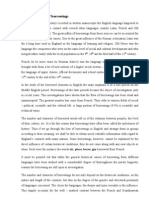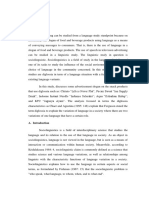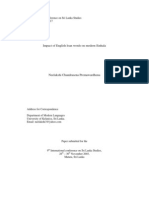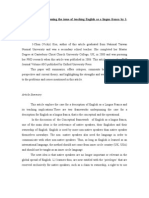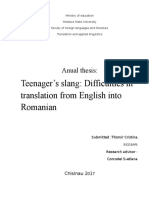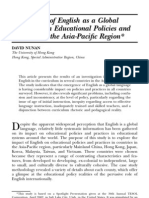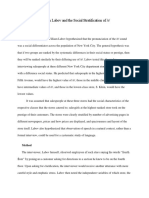100%(2)100% found this document useful (2 votes)
246 viewsCode Mixing or Code Switching
In communities that are traditionally monolingual, linguistic variation is prevalent. Awareness of this kind of variation is slight on the part of the speakers themselves. A macrolinguistic view may then seem overpretentious whereas a MICROLINGUISTIC approach tends to be somehow insufficient.
Uploaded by
magneto1981Copyright
© Attribution Non-Commercial (BY-NC)
Available Formats
Download as PDF, TXT or read online on Scribd
100%(2)100% found this document useful (2 votes)
246 viewsCode Mixing or Code Switching
In communities that are traditionally monolingual, linguistic variation is prevalent. Awareness of this kind of variation is slight on the part of the speakers themselves. A macrolinguistic view may then seem overpretentious whereas a MICROLINGUISTIC approach tends to be somehow insufficient.
Uploaded by
magneto1981Copyright
© Attribution Non-Commercial (BY-NC)
Available Formats
Download as PDF, TXT or read online on Scribd
You are on page 1/ 22
MATS THELANDER
Code-Switching or Code-Mixing?
1. From a methodological point of view, the analysis of linguistic
variation has to be adapted to the nature of this variation in each par-
ticular case.' In a community where one is dealing with two or more
substantially different languages in alternation it is possible, as a rule,
to work on a MACROLINGUISTIC level. In such cases it makes sense to ask
members of the community which language they would use in certain
specified situations and, with a reasonable knowledge of the different
languages, an observer has little difficulty in deciding in which speech
variety a certain speaker is expressing himself at any given instant.
According to this model, the speech repertoire falls into discrete (which
does notexcludesome portion ofcommon features) and locally recognized
varieties, codes, or systems.
In communities that are traditionally monolingual, linguistic variation
is also prevalent and a number of investigations over the last few years
have demonstrated how this variation is socially structured and, from a
functional point of view, analogous to a shift between markedly different
languages. For settings of this later type, however, it has usually been
felt more proper to apply a MICROLINGUISTIC approach. It is true that
mention is sometimes made of sociolects, registers or styles, as if they
were distinct systems of the repertoire, but at the same time the researcher
often contents himself with pointing at a correlation of single linguistic
variables with social strata or contexts. In many cases the awareness of
this kind of variation is slight on the part of the speakers themselves.
Due probably to an increase in geographical and social mobility in
recent years and to an explosive development of mass communication.
linguistic situations are now gradually emerging for which neither of
these two models for description can be automatically accepted. Neutral-
izing between existing varieties must be expected to take place, and the
consciousness among the speakers of a discrete opposition between
different varieties will become blurred as a cause or result of this process.
A macrolinguistic view may then seem overpretentious whereas a micro-
104 Mats Thelander
linguistic approach tends to be somehow insufficient. This certainly
is true of many settings where a local dialect has for some time been com-
peting with the standard variety of the society at large (cf., for instance,
Eriksson 1973). As has been argued by Blom and Gumperz (1972)
conditions like these do not, on the other hand, necessarily bring about
a complete state of flux. Although the linguistic distance between the
two varieties in Hemnes, Norway, is shown to be relatively small, the
authors conclude that for the time being there is little risk of a further
merging of the two. Being associated with different value clusters, local
vs. national, the codes themselves function as symbols in a sociosemantic
system which plays a vital part in marking and maintaining the double
identities of the Hemnes residents. As long as this distinction between
identities is felt to be locally significant, the two codes are likely to remain
segregated.
2. One of the aims of this paper is to make an attempt to apply Blom’s
and Gumperz’ model of code-switching to a small Swedish community,
which on the surface may show some resemblance to Hemnes. Being the
most obvious linguistic consequence of a functional differentiation
between varieties, a tangible code segregation will be regarded as the
decisive indication of a possible Hemnes-type of bidialectalism. In
order to acquire some objective measure of speech variation, the choice
ofasuitable level of description is discussed in some detail. A compromise
between a macrolinguistic and a microlinguistic approach will be
proposed : an index of dialect level which incorporates a model of discrete
speech varieties into a spectrum of continuous variation.
2.1. The site of investigation, Burtrisk, is a small community in a
traditionally agricultural area of northern Sweden. It is situated 25
miles from the nearest town, Skellefted (see map, p. 15). Of the approx-
imately 6,000 inhabitants of the district, the major part derive their
livelihood from small-scale farming and forestry work. This group used
to be much larger but because of the discontinuation and amalgamation
of unprofitable small-holdings, a lot of people have been forced to
abandon their native area. Strongly dominated by commercial and
service trades, the community center has been affected by depopulation
only indirectly. This village accommodates some 1,300 persons.
A Burtrask resident is quite proud of his community, he has most of
his friends and relatives close by, and he seldom finds reason to visit
other places. Most things are at hand. Whether he lives in the village
Code-S witching or Code-Mixing? 105
or in the surrounding countryside, he calls and considers himself
a burtraskare. One important symbol of this common identity AGAINST
THE OUTSIDE WORLD is no doubt the dialect, burtrdskmdl, which differs
considerably from the standard variety of Swedish. wITHIN THE COM-
MUNITY however, burtrdskmal is not the usual designation of the local
language. As in many other places in northern Sweden, people refer to
the home dialect as bondska, “‘the language of farmers”. This is not
altogether pejorative but it certainly suggests a dividing line in use and
attitudes between the villagers and the rural population. Even disregard-
ing the more formal situations, which for natural reasons are concentrated
in the village, it is quite noticeable that the dialect has a comparatively
weak footing among villagers. This makes it wise to modify the expecta-
tions of an organized bidialectalism in Burtrask. Although, with few
exceptions, people in Burtrask have a good understanding of both
standard Swedish and the dialect, it is dubious whether standard-speaking
villagers ever make personal use of the pure dialect or whether dialect-
speaking non-villagers ever employ a mode of speaking which to any
substantial extent differs from the dialect. To a direct question only 15
persons out of a sample of 52 declare that they do alternate between
dialect and standard with the intention of keeping them separated.
None of these are villagers. Another 23 persons admit that, depending
on the circumstances, their speech may be more or less dialectal, but they
prefer not to call it a regular shift. In this group quite a few villagers are
represented. At any rate, the way of speaking certainly is not unimportant
to the people in Burtrask. The following short extract from an authentic
recording may demonstrate that. As a specimen of genuine dialect the
text can also serve to illustrate the degree of difference between bur-
traskmal (D) and spoken standard Swedish (S). The latter version is of
course a construction:
n ‘dei: vaf je ‘se: at om dem bera va “etm ‘dé:n
en ‘de:l blir je ‘so at om dom bara er etm ‘den;
some people get to be such that if they are outside the door only
i *fjucton *de:ga se “cen: de int ‘at dem da dem
i *fjucton “decgago ‘cen:ar man inta ifjen: dom do dom
for fourteen days then you don’t recognize them when they
xkomia ...va ‘jere sem ‘jo:r ‘he:?
tkomier....va ‘eda som ‘joe: ‘de:?
come back . .. how can this be?
MEO Meo MED
106 Mats Thelander
2.2 Empirical data for this study were drawn from linguistic analyses
of 28 hours of recorded group discussions, supplemented by individual
answers to a questionnaire from 52 out of those 56 informants who took
part in the group discussions. With one or two exceptions the speakers
were all born and residing in either the central village of Burtrask or in
its immediate rural surroundings. The selection of informants can best
be described as a ‘judgment sample” (Labov 1963: 284) within the age
bracket 14 to 61 years. Informal group discussions were chosen for the
recordings to secure a fair amount of intra-individual speech variation
(cf. Gumperz 1972: 208). Each of the 14 group sessions lasted for two
hours and included four speakers. To a large extent the groups were
self-recruited (cf. Blom and Gumperz 1972: 426) and the discussions
took place in a relaxed atmosphere in the home of one of the members of
the group. All speakers knew that they were being recorded but to a
greater or lesser degree they were ignorant of the exact motive for this.”
For the purpose of generating a controlled shift of speech situation the
informants, after one hour of talking on their own, were joined by a
stranger introducing himself as member of the research staff. It seemed
reasonable to expect that this introduction would make the speakers
associate him or her with activities not belonging to the local sphere. To
make sure that the informants did not refrain from using their dialect
for reasons of intelligibility, care was taken always to engage a person
from the north of Sweden to play the part of “stranger”. The topics
under discussion varied from local gossip to world politics.
3. Linguistic variation on a microlevel is usually discrete in character. 3
The variable aj assumes (or is perceived to assume) either of the variants
@q OF a,, normally nothing in between. To talk about discrete variation
on a macrolevel as well (meaning that the speech alternates between the
distinct varieties V) and V,) would presuppose a high measure of
correspondence between different variables. One would expect variant
Ap to be consistently co-occurring with variant bo, rather than with by at
some instances and with an alternative form b, at others. This last-
mentioned state of affairs, on the other hand, is something one has to
take into account when examining the speech habits in a monolingual
community. The question then is if ina community like Burtriisk one has
to confine oneself to describing the variation as a continuum between the
extremes of dialect and standard, or if, after all, the variation can be seen
as a switch between a limited number of natural levels or discrete
varieties. This latter solution of course represents a more structured view
You might also like
- New Trends in Crosslinguistic Influence and Multilingualism ResearchFrom EverandNew Trends in Crosslinguistic Influence and Multilingualism ResearchNo ratings yet
- Milroy (1985) - Linguistic Change, Social Network and Speaker InnovationNo ratings yetMilroy (1985) - Linguistic Change, Social Network and Speaker Innovation47 pages
- Translanguaging and Named Languages: Productive Tension and DesireNo ratings yetTranslanguaging and Named Languages: Productive Tension and Desire12 pages
- A Critic of Politeness Theories (Gino Eelen)No ratings yetA Critic of Politeness Theories (Gino Eelen)5 pages
- A Guideline For Contrastive Analysis Research100% (1)A Guideline For Contrastive Analysis Research5 pages
- Bilingual Brokers: Race, Literature, and Language as Human CapitalFrom EverandBilingual Brokers: Race, Literature, and Language as Human CapitalNo ratings yet
- Impact of English Loan Words On Modern SinhalaNo ratings yetImpact of English Loan Words On Modern Sinhala9 pages
- 1999 Trudgill Dialect Contact, Dialectology and SociolinguisticsNo ratings yet1999 Trudgill Dialect Contact, Dialectology and Sociolinguistics8 pages
- Culture in Language Learning: Background, Issues and ImplicationsNo ratings yetCulture in Language Learning: Background, Issues and Implications10 pages
- A Cultural Semiotic Approach On A Romani PDFNo ratings yetA Cultural Semiotic Approach On A Romani PDF9 pages
- An Introduction To Variationist SociolinguisticsNo ratings yetAn Introduction To Variationist Sociolinguistics68 pages
- The Atlas Linguarum Europae As An Instrument For Eurolinguistic Research - Wolfgang ViereckNo ratings yetThe Atlas Linguarum Europae As An Instrument For Eurolinguistic Research - Wolfgang Viereck33 pages
- American English Social Dialect Variation and Gender100% (1)American English Social Dialect Variation and Gender4 pages
- Sociolinguistics Is The Study of The Effect of Any and All Aspects of SocietyNo ratings yetSociolinguistics Is The Study of The Effect of Any and All Aspects of Society8 pages
- English Syntax The Simple Sentence: Ioana Murar Ana-Maria Trantescu Claudia Pisoschi100% (1)English Syntax The Simple Sentence: Ioana Murar Ana-Maria Trantescu Claudia Pisoschi76 pages
- Language and Gender in English and Romanian: The State of The Art by Diana HornoiuNo ratings yetLanguage and Gender in English and Romanian: The State of The Art by Diana Hornoiu81 pages
- Complementation in English - Alexandra Cornilescu Part 175% (4)Complementation in English - Alexandra Cornilescu Part 1204 pages
- Interlanguage (Part I) : L1 Interference: L2 Spanish Learner L2 Spanish Learner L2 English Learner L2 English LearnerNo ratings yetInterlanguage (Part I) : L1 Interference: L2 Spanish Learner L2 Spanish Learner L2 English Learner L2 English Learner10 pages
- The Impact of English As A Global Language On Educational Policies and Practices in The Asia-Paci C Region100% (1)The Impact of English As A Global Language On Educational Policies and Practices in The Asia-Paci C Region25 pages
- Williamlabovscontributiontolinguistics 101206160743 Phpapp01No ratings yetWilliamlabovscontributiontolinguistics 101206160743 Phpapp0121 pages
- Cases of Domestication and Foreignization in The Translation of Indonesian Poetry Into English A Preliminary InquiryNo ratings yetCases of Domestication and Foreignization in The Translation of Indonesian Poetry Into English A Preliminary Inquiry9 pages
- Researching Vocabulary Through A Word Knowledge Framework: Word Associations and Verbal Suffixes100% (1)Researching Vocabulary Through A Word Knowledge Framework: Word Associations and Verbal Suffixes20 pages
- Raymond Hickey - Contrastive Linguistics (Introduction)No ratings yetRaymond Hickey - Contrastive Linguistics (Introduction)33 pages
- Comparative - Typological Investigation of Nouns in100% (1)Comparative - Typological Investigation of Nouns in59 pages
- William Labov and The Social Stratification of RNo ratings yetWilliam Labov and The Social Stratification of R3 pages
- Motivation, Language Identity and The L2 SelfNo ratings yetMotivation, Language Identity and The L2 Self5 pages
- New Trends in Crosslinguistic Influence and Multilingualism ResearchFrom EverandNew Trends in Crosslinguistic Influence and Multilingualism Research
- Milroy (1985) - Linguistic Change, Social Network and Speaker InnovationMilroy (1985) - Linguistic Change, Social Network and Speaker Innovation
- Translanguaging and Named Languages: Productive Tension and DesireTranslanguaging and Named Languages: Productive Tension and Desire
- Bilingual Brokers: Race, Literature, and Language as Human CapitalFrom EverandBilingual Brokers: Race, Literature, and Language as Human Capital
- 1999 Trudgill Dialect Contact, Dialectology and Sociolinguistics1999 Trudgill Dialect Contact, Dialectology and Sociolinguistics
- Culture in Language Learning: Background, Issues and ImplicationsCulture in Language Learning: Background, Issues and Implications
- The Atlas Linguarum Europae As An Instrument For Eurolinguistic Research - Wolfgang ViereckThe Atlas Linguarum Europae As An Instrument For Eurolinguistic Research - Wolfgang Viereck
- American English Social Dialect Variation and GenderAmerican English Social Dialect Variation and Gender
- Sociolinguistics Is The Study of The Effect of Any and All Aspects of SocietySociolinguistics Is The Study of The Effect of Any and All Aspects of Society
- English Syntax The Simple Sentence: Ioana Murar Ana-Maria Trantescu Claudia PisoschiEnglish Syntax The Simple Sentence: Ioana Murar Ana-Maria Trantescu Claudia Pisoschi
- Language and Gender in English and Romanian: The State of The Art by Diana HornoiuLanguage and Gender in English and Romanian: The State of The Art by Diana Hornoiu
- Complementation in English - Alexandra Cornilescu Part 1Complementation in English - Alexandra Cornilescu Part 1
- Interlanguage (Part I) : L1 Interference: L2 Spanish Learner L2 Spanish Learner L2 English Learner L2 English LearnerInterlanguage (Part I) : L1 Interference: L2 Spanish Learner L2 Spanish Learner L2 English Learner L2 English Learner
- The Impact of English As A Global Language On Educational Policies and Practices in The Asia-Paci C RegionThe Impact of English As A Global Language On Educational Policies and Practices in The Asia-Paci C Region
- Williamlabovscontributiontolinguistics 101206160743 Phpapp01Williamlabovscontributiontolinguistics 101206160743 Phpapp01
- Cases of Domestication and Foreignization in The Translation of Indonesian Poetry Into English A Preliminary InquiryCases of Domestication and Foreignization in The Translation of Indonesian Poetry Into English A Preliminary Inquiry
- Researching Vocabulary Through A Word Knowledge Framework: Word Associations and Verbal SuffixesResearching Vocabulary Through A Word Knowledge Framework: Word Associations and Verbal Suffixes
- Raymond Hickey - Contrastive Linguistics (Introduction)Raymond Hickey - Contrastive Linguistics (Introduction)
- Comparative - Typological Investigation of Nouns inComparative - Typological Investigation of Nouns in



